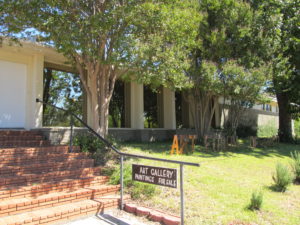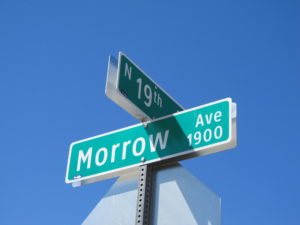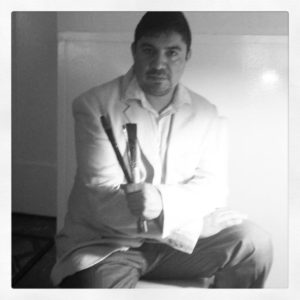By Kyle Massey
I am aware that the title of this article may have alarmed you. In our society, people don’t usually go around proclaiming to be racist. Therefore, it probably catches your attention when I say “I’m white, and I’m racist”. Well, it’s true, I don’t deny my racism. This may seem provocative, but let me explain.
Our society is one that was built on, and continues to be, a system of exploitation and oppression of people of color by white people. This is historically based and institutionally perpetuated. This racist social structure is designed for white people to maintain and defend a system of wealth, power, and privilege. This structural racism—the forms of racism that act visibly and invisibly in our institutions—is a principal component of the fabric of our society, whether we see it or not, and manifests itself in practically every element of our social structures. Our nation’s policies and systems of education, immigration, [in]justice, healthcare, housing, and employment, for example, have been, and continue to be, deeply influenced by structural racism. That is, structural racism works through willing and unwilling actors through these social structures to produce and reproduce cumulative, durable, race-based inequalities to privilege the white majority.
It’s in the air we breathe
Structural racism is so deeply ingrained in our society, in everyday behaviors, practices, thoughts, and actions that exposure to it is inescapable (but not unresolvable). It is simply impossible to have grown up in a white supremacy as a member of the majority and not have absorbed racist beliefs or tendencies of some kind. It’s in the air we breathe. This is why white people contribute to the creation of a racist society. There, I said it: white people are racist.
If you’re a white person reading this, you may be feeling a bit defensive right now. You may be thinking to yourself that you are not racist because you have friends who are black or because you don’t go around yelling racist slurs at people of color. It is important to recognize that racism is not just outward and visible actions, it is also the biased ideas we might hold deep inside, that we don’t voice. Our racism takes many forms and because our white supremacist society has normalized and legitimated racist thoughts and actions for so long, white people are not always able to spot their own racism. The oppressed in our society, however, recognize it and are hurt by it every day… so if you’re having trouble identifying the ways you might show racism, just go ask some of your friends who are not white.
Although white people in our society perpetuate this state of racism, I am not suggesting that all white people feel hatred toward people of color or even harbor ill feelings about them. What I am saying is that all white people have, in some way, been privileged and socialized on the basis of race by our white supremacist (racist) society. I am complicit because I am a member of the white majority in a white supremacy – I am a member of the group that holds the power in our society. I have grown up in this environment while occupying this particular identity, and therefore I have taken on some of the prejudices.
Although this blog post focuses on race, we should also acknowledge that advantage and disadvantage works in different constellations and that social race is only one axis among many (ability, gender, economic status, religion, sexual orientation, etc.).
The shame is denying our privilege
It may not have necessarily been my fault that racist things have been ingrained in me because, as I have said, it’s impossible to avoid this in a white supremacist society. The most shameful and destructive part, however, is when white people deny it: when we deny our privilege, when we don’t own up to the damage we cause, and when we don’t put in the effort to understand it or to figure out how to transform ourselves. Instead of denying our racism, we must call it out and be intentional about working toward understanding and transformation. And it is work. While structural racism is pervasive and has been a major component in the framework our society, it is also very sophisticated, and, in a way, elegant. It easily disguises itself. Various forces within the system of structural racism continually work to deny, minimize, and ultimately uphold itself. Working to unpack it so the racism is recognizable can be challenging work for the privileged in society.
There is of course a massive variation in how racism manifests itself in and through us. Some white people commit murder and hate crimes on the basis of race. Some people belittle other people’s cultures. Some white people discriminate based on race in hiring processes within employment settings. For others, their racism manifests in less overt ways. Some people may laugh at racist jokes, for example, or cross the street when walking along a sidewalk to avoid crossing paths with an oncoming black pedestrian. Still others may observe racist acts committed by others and choose not to speak up. Such inaction is complicity. These less overt examples of racism, often called microaggressions, are certainly not of the same magnitude as violent hate crimes, but they do share the same origins and are intrinsically linked.
I didn’t ask to be racist. It’s not something that I want. But, whether or not I like it, I have been shaped by our dominant culture, our racist culture. Similarly, I didn’t ask for white privilege, but it was given to me. I cannot give it back any more than I could have chosen not to take it. What I can do is own it, and I do own my privilege. What I mean is that I work to identify it, describe it, and call it out with the hope of lessening it.
Racist by conditioning, antiracist by choice
Even more importantly, I am an antiracist. I’m racist by conditioning, but I am an antiracist by choice. I choose to challenge white privilege and the oppression of people of color. But, just because I choose to be an antiracist doesn’t mean that I no longer carry around some of the traces of racism to which I have been exposed and poisoned by all my life. So, fellow white people, although racism is part of who we are, it is not all of who we are. We can all make the choice to be an antiracist, an ally, an activist, or whatever you want to call it. But we can’t actually embody these roles in society unless we first recognize and deal with our own racism, not deny it. I believe it is important, perhaps even necessary, for true transformation that each white person in our society comes to a place where they are able to say, “I’m white and I’m racist and I’m going to do something about it”.
And doing something about it will be the focus of Part 2 of this blog series, which will be posted here next Sunday. This second post will focus on the various ways that all people, as antiracists, can work toward equity and inclusion in our community and in our society more broadly.
 Kyle Massey is an educator, student, and scholar. Kyle lives and works in Waco, Texas. In addition to his fulltime job as a higher education administrator, in the evenings Kyle teaches undergraduate courses in geography and leadership studies. He is a PhD student at the University of Texas at Austin in the College of Education. Kyle’s research interests include topics related to global citizenship, geography education, and the ways in which various aspects of curriculum and teaching in higher education shape student learning experiences, especially with respect to social and cultural understandings. You can contact Kyle at [email protected], follow him on Twitter @kyledmassey, and check out his website at www.kyledmassey.com
Kyle Massey is an educator, student, and scholar. Kyle lives and works in Waco, Texas. In addition to his fulltime job as a higher education administrator, in the evenings Kyle teaches undergraduate courses in geography and leadership studies. He is a PhD student at the University of Texas at Austin in the College of Education. Kyle’s research interests include topics related to global citizenship, geography education, and the ways in which various aspects of curriculum and teaching in higher education shape student learning experiences, especially with respect to social and cultural understandings. You can contact Kyle at [email protected], follow him on Twitter @kyledmassey, and check out his website at www.kyledmassey.com
The Act Locally Waco blog publishes posts with a connection to these aspirations for Waco. If you are interested in writing for the Act Locally Waco Blog, please email [email protected] for more information.
[Photo 1 by Flickr user pigeonpoo – used under Creative Commons licensing]
[Photo 2 by Flickr user Light Brigading – used under Creative Commons licensing]
by Jenuine Poetess
In June of this year, I was met with an opportunity to submit a proposal to present at the 10th Annual Strengthening Youth and Families Conference in San Marcos, Texas. I eagerly perused the prompts for possible workshops and break-out sessions and began to formulate an outline. Within several weeks I submitted my proposal for consideration. It was a brave move on my part; this conference looked like a pretty big deal and I have never presented in such a setting before. For better or worse I decided that at the very least, the process would be informative and shaping for me. I was thrilled when I received word two months later that my proposal had been accepted and I was invited to be among the talented and dynamic conference presenters.

Some of the fine folks who attended my workshop at the 10th Annual Strengthening Youth and Families Conference November 6, 2014. San Marcos, Texas.
Earlier this month I made the trip to San Marcos and with my “First Timer” name badge I boldly went where I had never gone before with confidence and courage. My workshop? How Art Transforms Youth and Their Communities. My attendees? Counselors, teachers, social workers, mentors, therapists, pastors, probation officers, foster parents, principals, juvenile justice professionals, case managers, and parents. I relished the opportunity to share my passion, experience, and resources with professional colleagues to inspire and affirm ideas for engaging youth in creative practices.
Across the span of my life I have served the generations next in a myriad of roles including: camp counselor, mentor, church youth leader, foster mother, supervisor/manager, teacher, trainer, therapist (mental health), sister, artist, poet, community organizer, and collaborator. I have worked with youth within systems and institutions such as education, corrections, and churches. I have built relationships through community spaces and projects. I have sat in the deepest dark of night to comfort young ones in the throes of nightmares—both imagined and real. I have walked with the vulnerable through their most harrowing traumas and have witnessed the profound liberation of their healing victories. I have wept over my own limitations and the haunting questions of, “have I done/am I doing enough?” In every setting and role, art has played a vital role in fostering the powerfully transformative relationships I have had the honor and privilege of building with so many extraordinary youth over the last two decades.
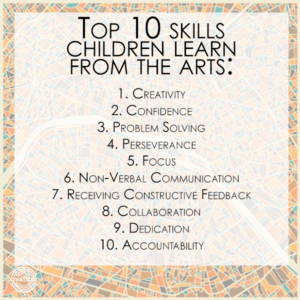 I came across the infographic to the right along with a corresponding article in the Washington Post as I was doing research for my presentation. I used this as a foundation and categorized the 10 skills into four key components of empowered youth development:
I came across the infographic to the right along with a corresponding article in the Washington Post as I was doing research for my presentation. I used this as a foundation and categorized the 10 skills into four key components of empowered youth development:
- Coping Skills
- Self-Awareness
- Resilience Training
- Empathy Building
The Top 10 Skills and my four categories fall in line with a guide released in the 1990s by the Search Institute on the 40 Developmental Assets which they found vital to nurturing a thriving youth. These 40 components are comprised of both internal and external qualities necessary to shape a young person into an individual who has a strong sense of self, a vision for their purpose, and a desire to contribute in meaningful ways to their communities and the world beyond them. Again and again, research and practice has shown that youth who engage in consistent creative outlets through school or community arts programming have greater opportunity to cultivate the skills that will foster their flourishing.
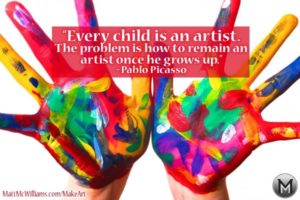 This past summer, I was invited to facilitate a writing circle workshop with students at La Vega High School during their after-summer-school program. Four young women and I met weekly for four weeks writing and sharing together. Inside the circle they were given prompts to write about—any genre—and every week I was humbled and awe-struck at the strength, courage, and creativity of these brave young voices. Whether through poetry, sci-fi fan fiction, personal reflections, or stories, these girls worked through issues of identity, self-esteem, healing, peer pressure, future goals, relationships, loss, and struggle. They learned how to find their own voice, amidst the cacophony of voices in their lives—parents, teachers, friends, media—and how to turn up the volume truly listening to who they are becoming.
This past summer, I was invited to facilitate a writing circle workshop with students at La Vega High School during their after-summer-school program. Four young women and I met weekly for four weeks writing and sharing together. Inside the circle they were given prompts to write about—any genre—and every week I was humbled and awe-struck at the strength, courage, and creativity of these brave young voices. Whether through poetry, sci-fi fan fiction, personal reflections, or stories, these girls worked through issues of identity, self-esteem, healing, peer pressure, future goals, relationships, loss, and struggle. They learned how to find their own voice, amidst the cacophony of voices in their lives—parents, teachers, friends, media—and how to turn up the volume truly listening to who they are becoming.
 I watched as these young women became more confident in their own words. I relished seeing a light glow from within as they began to trust that they have a story to tell the world and that their unique story matters so much. Though our time together this summer was short, it is my deepest hope that the seeds of creative expression through the written and spoken-word arts continue to grow and bloom within them, for an individual empowered to know and share their story is an unstoppable force for transformation.
I watched as these young women became more confident in their own words. I relished seeing a light glow from within as they began to trust that they have a story to tell the world and that their unique story matters so much. Though our time together this summer was short, it is my deepest hope that the seeds of creative expression through the written and spoken-word arts continue to grow and bloom within them, for an individual empowered to know and share their story is an unstoppable force for transformation.
“I’m inspired!…now what?”
If you or an organization with which you are affiliated is interested in starting or strengthening arts programming, I would be delighted to collaborate and consult with you. I have starter kits for writing circles and open mic venues as well as heaps of resources for visual, written, and spoken-word arts projects. I love engaging directly with youth as well as providing adults the tools and support to cultivate creative practice in youth. From printable color sheets to art therapy activities to event planning I am always eager to share what I have and know to expand the impact of arts and culture in and around Waco. Please contact me at: [email protected].
 Jenuine Poetess is an artist, visionary, and community organizer. In 2010, she founded In the Words of Womyn (ITWOW), an international, grass-roots, written and spoken-word arts project with chapters throughout Los Angeles; Waco, TX; and Lebanon. ITWOW empowers womyn of all ages to give sound to our story and volume to our voice. Jenuine also co-hosts Nuestra Voz & Word Gallery, monthly open mic venues for poetry, music, spoken-word, story-telling, and more! You can contact her at: [email protected].
Jenuine Poetess is an artist, visionary, and community organizer. In 2010, she founded In the Words of Womyn (ITWOW), an international, grass-roots, written and spoken-word arts project with chapters throughout Los Angeles; Waco, TX; and Lebanon. ITWOW empowers womyn of all ages to give sound to our story and volume to our voice. Jenuine also co-hosts Nuestra Voz & Word Gallery, monthly open mic venues for poetry, music, spoken-word, story-telling, and more! You can contact her at: [email protected].
The Act Locally Waco blog publishes posts with a connection to these aspirations for Waco. If you are interested in writing for the Act Locally Waco Blog, please email [email protected] for more information.
by Kelly McDonald
The second Affordable Health Care Act Insurance Marketplace open enrollment period kicked off on November 15. Get Covered America along with the Family Health Center, Providence Hospital, Baylor Scott & White Hillcrest Medical Center, Heart of Central Texas Independent Living Center, and Planned Parenthood are hosting health insurance enrollment events and encouraging McLennan and surrounding residents to sign up for quality, affordable health coverage. The open enrollment and renewal period that began Saturday, November 15 runs through December 15 for health plans that start or renew on January 1, 2015.
Last open enrollment period over 733,000 Texans got covered (3,733 of those from McLennan County) and 8 out of 10 of them received financial help to pay for their monthly health insurance premiums. According to the 2012 U.S. Census (the most recent year for which data is available) 40,000 McClennan county residents were uninsured. With roughly 25% more health insurance companies and health plans available in the Marketplace this time around, the McLennan Health Insurance Marketplace Coalition wants to make sure that these uninsured residents and those renewing their healthcare plans (1) know about their new health insurance options, (2) know that financial assistance may be available to help them pay for their monthly premiums, and (3) know that there are bilingual in-person assisters in the community to help them with their application and to answer any questions they may have to #GetCovered and #StayCovered.
Throughout the county, residents will be able to meet with non-profit application counselors who can walk them through the sign-up process free of charge and determine how much financial help they may qualify for. Residents can go to https://getcoveredamerica.org/calculator for an estimate on what Marketplace insurance costs and the amount of financial assistance they may qualify for, and to https://www.getcoveredamerica.org/events/ to locate or sign up to host upcoming enrollment events.
It’s also important to know that some households will need 2015 coverage to avoid paying a fine when they file their income taxes. 2015 fines can be as high as 2% of annual taxable income per adult without coverage, and 1% per child. Some low income individuals and families are exempt from the penalty, but should still apply for coverage to learn all their options. Some family members may qualify for Medicaid or CHIP.
For more information about how the Open Enrollment period will work in McLennan County, please plan to attend the McLennan Health Insurance Marketplace Enrollment Event Kickoff. The information will be delivered in both English and Spanish.
What: McLennan Health Insurance Marketplace Enrollment Event Kickoff – English and Spanish
Where: South Waco Library 2737 S. 18th St., Waco, TX 76706
When: Tuesday, November 18, 2014 from 5:00p.m. – 8:00p.m.
Who: Providence Hospital, Heart of Central TX Independent Living Center, Planned Parenthood, Family Health Center, Baylor Scott & White Hillcrest Medical Center and Get Covered America
How: For more details please contact Kelly McDonald at (254) 405-2576 or [email protected].
 This post was written by Kelly McDonald. Kelly is the Community Outreach Organizer with Get Covered America. She’s also a legislative advocate for people with rare diseases, and on issues of genetic privacy. Ms . McDonald is an Executive Officer for the National PKU Alliance, and serves on the Newborn Screening advisory board of the Texas Legislature.
This post was written by Kelly McDonald. Kelly is the Community Outreach Organizer with Get Covered America. She’s also a legislative advocate for people with rare diseases, and on issues of genetic privacy. Ms . McDonald is an Executive Officer for the National PKU Alliance, and serves on the Newborn Screening advisory board of the Texas Legislature.
Would you be interested in blogging for Act Locally Waco? If so please email [email protected].
by Phil York
Believe it or not, only 35 business days remain until Christmas Day. This headline would intimidate most, but not this seasoned last minute shopper. I consider it a countdown to when I will surely shine the brightest. For many of us holiday traditions offer community, love, hope and the promise of a New Year. Some of our neighbors, however, endure hardships each month of the year. The holiday season seems to highlight this fact as their struggles stand in sharp contrast to the bright lights and carols in the weeks ahead.
While some of our neighbors turn to family and friends, the faith community or the nonprofit sector of Waco for assistance, others may decide to ask the community directly for support. “Panhandling,” or the act of asking for money, food or goods publicly, is our blog topic today.
Stereotypes of Panhandling Unwrapped
Panhandling is often closely associated with homelessness, but it is important to note that all panhandlers are not necessarily homeless, and only a relatively small percentage of homeless people engage in panhandling. According to a report published in the Urban Affairs Review in 2003, less than 15% of the homeless people sampled reported having engaged in panhandling.
According to this same report, which compared homeless people who panhandled with those who did not, those who engage in panhandling tend to be those who lack personal relationships such as marriage or children. They tend to have been homeless more often and for longer periods of time, and they are more likely to have alcohol, drug or mental health problems. This combined set of factors may make it more difficult for this group of people to find legitimate employment, making it more likely that they will turn to panhandling as a means of survival.
Waco Ordinance
Sympathetic as a panhandler’s predicament may be to some, cities often work to discourage panhandling out of a concern that it may be bad for business. Like many cities, The City of Waco has a panhandling ordinance. In Waco, panhandling is not allowed on public streets, roadways or medians. In addition, people who are panhandling (soliciting) may not, for example:
- Continue efforts to solicit from a person once that person has indicated they do not wish to be solicited from.
- Misrepresent the purpose of the solicitation
- Engage in conduct that creates a safety or traffic hazard.
- Or, use children to solicit funds.
Ordinances against panhandling, however, do not completely solve the problem. For one thing, enforcing them comes at a cost. According to the report quoted above, “the average cost of detaining an individual in jail is roughly 25% higher than the daily cost of providing an individual with shelter, food, transportation and counseling services.” For another thing, they do little to address the root causes of the problems that lead to the panhandling.
What should we do when we are asked by a neighbor for money?
Decline out of love – According to a 2012 Trib article on panhandling in Waco, Teri Holtkamp, the City of Waco’s homelessness coordinator discourages giving money. “You never really know where the money is going,” she said. “You may be supporting drugs or prostitution. So, rarely are you really helping a person out.” “Don’t just give because you feel guilt,” she said. “If you want to make lasting change, you have to say, ‘I love you enough not to give you money, because I don’t know where it’s going.’” In a recent e-mail, Ms. Holtkamp reiterated those sentiments stating, “People deserve real change not spare change.”
Recognize the human dignity – What you can give is a smile, recognition of human presence, and perhaps directions to an agency or ministry that can help.
Give Wisely – If you would like to give something directly to a person asking you for help, a meal at a fast food restaurant, a bus pass or a snack from a convenience store are better choices than giving cash. (Note: Do not to serve food directly on the street without first contacting the City of Waco for the proper permits.)
Teri Holtkamp suggests that instead of giving handouts on the street, well-meaning people might consider giving their money to an agency. “When you give to the agency you know where your dollars are going,” she said. Also, as Jimmy Dorrell, founder and executive director of Mission Waco, stated in the 2012 Trib Article cited above, “… generally, when people become so desperate that they beg for food, they have other issues they need to address.” Two organizations in Waco that can help with those issues are The Salvation Army and Mission Waco. The Salvation Army serves hot meals 365 days a year at the Community Kitchen, located near downtown Waco at 300 Webster Ave. Meals are available to anyone who asks. Mission Waco’s social services, including access to the “My Brother’s Keeper” shelter, are available through the Meyer Center at 1226 Washington.
The Easiest Gift to Wrap
I had the honor to work at the National Coalition for the Homeless a few years ago. I assisted the Speakers Panel Program: an event that allowed high school students to hear from formerly homeless citizens of Washington, DC. When one of our speakers, Sarah, was asked, “What was the worst thing about being homeless? The Winter?” Sarah took a deep breath, wrestled with tears that eventually fell, and said, “The worst part about being homeless is the fact that people see right through you…ignore your existence…a smile and hello always shocked me in the rare times they were given and always changed the tone of my day.”
The holiday season is upon us. Gift shopping is on the agenda for most. If you are asked to give by a person on the street, remember Sarah’s soul-penetrating reminder of our shared human dignity and how the best gift can be something that we can all afford to give and to receive this holiday season.
 Phil York, Director of Development at Waco Habitat for Humanity, is a self-described “policy nerd;” he is also the Act Locally Waco housing and homelessness policy blogger. You can direct questions to Phil to [email protected]. Would you be interested in blogging for Act Locally Waco? If so please email [email protected].
Phil York, Director of Development at Waco Habitat for Humanity, is a self-described “policy nerd;” he is also the Act Locally Waco housing and homelessness policy blogger. You can direct questions to Phil to [email protected]. Would you be interested in blogging for Act Locally Waco? If so please email [email protected].
by Kenneth Moerbe
As you satisfy your book addiction at the upcoming 52nd Annual Friends of the Library Book Sale, I want you to realize that in this case, satisfying an addiction, is also doing something very supportive of the Waco-McLennan Libraries. Yes, your uncontrollable craving for the latest book by Jodi Picoult or John Grisham, or David Baldacci, or Tom Clancy, or Barbara Kingsolver can result in something very, very positive for our local libraries! What do I mean suggesting that an addiction can be positive for our community?
 Let me explain. The four day book sale, probably one of the largest in the State of Texas, generates funds to provide many wonderful experiences in our libraries for thousands of our children and adults. We are blessed to have a committed city government that has budgeted something over $3.5 million this year to provide the vast bulk of the materials and staff support for our libraries. But the real ‘icing on the cake’ of our local libraries is provided by the funds generated by the book sale. The Friends of the Waco/McLennan County Library is a volunteer organization that exists for the sole purpose of improving the quality of life in our community through support of the Waco-McLennan County Library. The hours of hard work devoted to the book sale by dozens of members and supporters of the Friends of the Library combined with your lust for historical fiction, or poetry, or non-fiction,or romance novels, or any of a dozen other genres that we folks who love to read can’t resist, pays for the programming that makes our libaries a hub of community life.
Let me explain. The four day book sale, probably one of the largest in the State of Texas, generates funds to provide many wonderful experiences in our libraries for thousands of our children and adults. We are blessed to have a committed city government that has budgeted something over $3.5 million this year to provide the vast bulk of the materials and staff support for our libraries. But the real ‘icing on the cake’ of our local libraries is provided by the funds generated by the book sale. The Friends of the Waco/McLennan County Library is a volunteer organization that exists for the sole purpose of improving the quality of life in our community through support of the Waco-McLennan County Library. The hours of hard work devoted to the book sale by dozens of members and supporters of the Friends of the Library combined with your lust for historical fiction, or poetry, or non-fiction,or romance novels, or any of a dozen other genres that we folks who love to read can’t resist, pays for the programming that makes our libaries a hub of community life.
Here are just a few of the efforts which have been funded so far in 2014 through this annual Book Sale:
- Author presentations and signings
- Free Children’s activities like the Crafty Kids Class, Sensory Storytime, Kids’Computer Classes, Spanish Storytime, Rubber Band Weaving MEET UP, Family Nights @ CENTRAL, Toddler Time, Storytime for Ages 3-6, Baby Time @ West Waco, Block Party @ Central
- Summer Reading Club Performer Fees, Children’s Summer Reading Club Incentives, Tween/Teen Summer Reading Club Incentives, Adult Summer Reading Club Incentives, Book Club Kits for County Libraries, Legos Lab @ Central
- Support and Grants for Little Free Libraries (LFLs) sponsored by Waco Community Development, LFLs created and developed by Rapoport Academy students
- Books for after-school reading instruction sponsored at Estella Maxey by Restoration Haven, Books in English provided over the summer through the Hewitt Library for children of migrant workers
- Material budget supplements of $35,000 for additional materials needed by Central, West Waco, East Waco, and South Waco Libraries, as well as the Genealogy Library, located a the West Waco Library, and the e-book services throughout the library system
- Library awareness and marketing services through bus benches and billboards, Chamber of Commerce directories, sponsorships of the Greater Waco Education Summit Scholarships, and One Book One Waco
- In-kind donations including thousands of items which were added to the Library collections, as well as given to the Hewitt, West, Moody, and McGregor libraries, donated through the Book Sale
- Photo Scanner for The Local History and Archives Project, automatic letter folder for Technical Services, a media browsing chest and additional shelving for DVD and Books-on-CDs for South Waco
Need I say more? Please plan to come and ‘satisfy’ your addictions for good reading at the 52nd Annual Library Book Sale sponsored by the Friends of the Waco McLennan County Library. November 6-9, at the Extraco Center’s Creative Arts and General Exhibits Building. For all the details, click here: 52nd Annual Friends of the Library Book Sale. See you there!
 This post was written by Kenneth Moerbe. Kenneth is a Lutheran minister and the former executive director of Caritas. He has participated on just about every committee and task force in town that has anything at all to do with increasing food security or reducing poverty. When he and his wife, Paula, are not gallivanting all over the world on one of their many travels, they are busy serving on various boards, delivering Meals on Wheels and generally being two of the finest and most fun folks in Waco.
This post was written by Kenneth Moerbe. Kenneth is a Lutheran minister and the former executive director of Caritas. He has participated on just about every committee and task force in town that has anything at all to do with increasing food security or reducing poverty. When he and his wife, Paula, are not gallivanting all over the world on one of their many travels, they are busy serving on various boards, delivering Meals on Wheels and generally being two of the finest and most fun folks in Waco.
The Act Locally Waco blog publishes posts with a connection to these aspirations for Waco. If you are interested in writing for the Act Locally Waco Blog, please email [email protected] for more information.
by Liz Ligawa
 Chances are you have reached this article through a post on your Facebook newsfeed. Being well-versed in the ins and outs of this media outlet, you are probably well aware of a coveted, and infamous symbol. A symbol that is used to convey quick, but not necessarily thorough, feedback. A symbol that will be used 1.8 million times in the next 60 seconds. A symbol that right now probably sits lonely and desaturated in shades of grey and disregard; but by the end of this article, may glow with an affirmative shade of blue: the “Like” button.
Chances are you have reached this article through a post on your Facebook newsfeed. Being well-versed in the ins and outs of this media outlet, you are probably well aware of a coveted, and infamous symbol. A symbol that is used to convey quick, but not necessarily thorough, feedback. A symbol that will be used 1.8 million times in the next 60 seconds. A symbol that right now probably sits lonely and desaturated in shades of grey and disregard; but by the end of this article, may glow with an affirmative shade of blue: the “Like” button.
Now, imagine with me the completely unlikely event that you reach the end of this article and find yourself dissatisfied with the exposition of this subject, or at odds with the perspective of its astute author. If you find that you do not like this article, do you have the same options available to you to “dislike” as you do to “like”? The answer is no, and this absence speaks volumes about our culture’s relationship with dissent. But is agreement the only useful reply?
In social work, one of the skills we are required to learn and develop in becoming competent practitioners is a skill called Reaching for Negative Feedback. When using this skill, the social worker intentionally asks his client for feedback concerning unmet expectations, incompatible goals, unwanted outcomes, or any client experience which could be improved upon. It is a vulnerable yet valuable position for the social worker, and an honoring position for the client. At first, I did not comprehend the necessity of this skill, nor understand why we had to inquire about discontent. That was until I considered our boardrooms, our workrooms, our classrooms, even our living rooms — all common places in which we do not readily give permission to disagree. When was the last time you disagreed about a certain course of action where you work, or learn? When was the last time you were asked about it?
In her TED talk, speaking about the power of disagreement, Margaret Heffernan shares the benefits that disagreement has on progress and development. According to Heffernan, great teams and businesses are created when “people are allowed to deeply disagree.” This concept seems to go against what we have been taught about leadership and management. How do we build consensus if we encourage disagreement? What levels of success might we expect from a company that approves dissent? The issue that Heffernan raises is that it’s not that we never disagree with matters in our workplace, homes, or our communities; it is that most of us simply never voice it.
During a recent meeting I had with my mentor, I found myself struggling with the experience of a lack of permission to disagree. My mentor listened intently as I described my attempts to resolve a progressively, deteriorating dilemma. She would interject, calmly, and pause – giving me time to recognize in my own voice the discomfort I was experiencing. Suddenly, in the midst of my exasperation, she said, “You can say that, Liz. You need to know you can say that.” I stopped. She waited. Everything paused as I observed this unfamiliar, yet deeply empowering gift of permission. I did not know it, but I had been struggling with respecting the power of dissent.
 What was your response the last time you were uninterested, or displeased with a post? Sometimes dissent will be referenced in the comments, but most of the time, it will simply be through the “Like” button left to its passive, default grey. This lack of comment, lack of dissent, takes a significant toll on the strength of our organizations. We sacrifice critical thinking, creativity, and growth. What tends to grow in this type of environment is a sterilizing culture of fear and resentment.
What was your response the last time you were uninterested, or displeased with a post? Sometimes dissent will be referenced in the comments, but most of the time, it will simply be through the “Like” button left to its passive, default grey. This lack of comment, lack of dissent, takes a significant toll on the strength of our organizations. We sacrifice critical thinking, creativity, and growth. What tends to grow in this type of environment is a sterilizing culture of fear and resentment.
Are we bold enough to hear what others have to say? Am I bold enough to receive negative feedback from this post? Waco, we have a lot to offer one another. We are enriched by our many voices; if only we will give them room to be. The integrity of our ideas is not held together by neatly spaced stitches of affirmation, or commendation. Our ideas should show indications of wear, and use. They should have fingerprints and smudges; evidence of being held and evaluated by others. Let them be worn and disheveled; let them be tattered and renovated. Let them be anything other than praised without inspection.
For two decades, Dr. Alice Stewart was the sole dissenter against using radiology on pregnant women due to the effects she observed in the unborn child. In our own country, the Civil Rights Movement was carried by those willing to stand for a collective voice of dissent to the nation’s laws. In Ferguson, a heartbroken community seeks justice through its gathered voice of dissent. Dissent should not be as easy to disregard in our everyday lives as it is on social media. It should find a common respect among other celebrated forms of communication.
You have now reached the end of this article. Consider this my formal attempt at Reaching for Negative Feedback. When was the last time you heard, “Dissenting opinions accepted here”?
 This post was written by Liz Ligawa. Liz is a graduate student of Baylor University where she has found the perfect expression of her community-centered heart in the MDiv/MSW degree program. With a concentration on Community Practice, she is also the adoring mother of one son, Elijah, who prefers to be regarded in public as Spider-Man. She may be reached at [email protected].
This post was written by Liz Ligawa. Liz is a graduate student of Baylor University where she has found the perfect expression of her community-centered heart in the MDiv/MSW degree program. With a concentration on Community Practice, she is also the adoring mother of one son, Elijah, who prefers to be regarded in public as Spider-Man. She may be reached at [email protected].
The Act Locally Waco blog publishes posts with a connection to these aspirations for Waco. If you are interested in writing for the Act Locally Waco Blog, please email [email protected] for more information.
by Stephanie Drum
Did you know that alcohol is the most abused drug among youth and young adults in the state of Texas? Did you know that providing alcohol to minors is a more serious offense than a DWI?
I am the new VASA coordinator for McLennan County. VASA stands for “VOICE Against Substance Abuse.” VASA is a community coalition, a group of concerned adults and youth working together to address issues related to underage/binge drinking, marijuana use, and prescription drug abuse in McLennan County. Our vision is creating a drug and alcohol free culture for youth and young adults.
Last month, I was in Austin with coalition representatives from all over the state of Texas, learning how to identify and address alcohol, marijuana and prescription drug abuse in young adults. I was particularly interested in the success stories shared by seasoned professionals. During the presentations, I furiously scribbled notes about potential strategies we could utilize in McLennan County. I was heartened because many of the communities who were sharing success stories started out by doing exactly what our VASA is doing right now: gathering data.
Specifically, we are gathering data to identify the status of alcohol, marijuana and prescription drug use and abuse in our county. We are in the process of conducting a survey of McLennan County residents, including students, parents and community members, to analyze the use and abuse of alcohol, marijuana and prescription drugs among young adults. The data will also provide an understanding of the community’s perception of substance use and abuse.
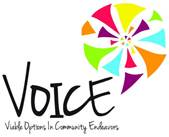 In addition to gathering information, we are implementing environmental strategies such as media campaigns to raise awareness of the dangers of alcohol use and abuse by minors during prom and graduation seasons and the consequences faced by adults who purchase alcohol for minors.
In addition to gathering information, we are implementing environmental strategies such as media campaigns to raise awareness of the dangers of alcohol use and abuse by minors during prom and graduation seasons and the consequences faced by adults who purchase alcohol for minors.
We would love for everyone in McLennan County to know about the VASA and to join us in our work. Here are three basic facts to get you started:
- The VASA coalition is a partnership comprised of community members from various sectors, including students, parents, volunteers, law enforcement, health agencies and many others, who have a stake in the well-being of their community regarding substance abuse.
- The purpose of the coalition is to encourage community mobilization to make changes in community policies, laws and social norms by utilizing data gathered through research and implementing strategies that been proven to be effective in other communities around the state.
- The Texas Department of State Health Services is funding the coalition for five years; the goal is for it to become self-sustaining when the grant ends. The grant is administered locally by VOICE, the largest provider of youth substance abuse prevention services in Texas.
Just like you, I desire safe and healthy environments in which our children and youth can grow and develop into responsible adults, capable of making good decisions. I believe that we can make great strides towards this goal by working together to change the ways in which illicit consumption of alcohol, marijuana and prescription drugs are identified and addressed in our community.
To learn more about the VASA Community Coalition and how you can be a part of our efforts, please contact me.
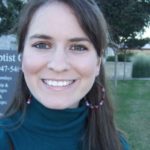 Stephanie Drum is the VASA Community Coalition Coordinator and works at VOICE. She has a Bachelor of Arts from the University of Mary Hardin-Baylor and a MDiv/MSW from Truett Seminary and Baylor University. She loves baking, the country and all kinds of art. Please contact her at [email protected] or (254) 741-9222 – she would love to share more about VASA Community Coalition!
Stephanie Drum is the VASA Community Coalition Coordinator and works at VOICE. She has a Bachelor of Arts from the University of Mary Hardin-Baylor and a MDiv/MSW from Truett Seminary and Baylor University. She loves baking, the country and all kinds of art. Please contact her at [email protected] or (254) 741-9222 – she would love to share more about VASA Community Coalition!
The Act Locally Waco blog publishes posts with a connection to these aspirations for Waco. If you are interested in writing for the Act Locally Waco Blog, please email [email protected] for more information.
by Gretchen Eichenberg
Last spring, a most unlikely group of fans never missed one of my daughter’s Lake Air Little League softball games. In my 10 years of sitting in those stands, I had never seen this group of softball enthusiasts before. I knew they hadn’t come to see my daughter — and for most of the season, I wasn’t sure whom they were there to cheer on. There were five to six middle-aged men —all with different intellectual and developmental disabilities — and they watched the game intently and commented on the plays just as if they were at a Rangers game.
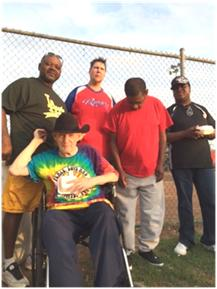 Each brought with him a 79-cent bag of Tom’s brand popcorn, probably purchased at a convenient store on the way to the fields. And they enjoyed every crunchy bite of that popcorn about as much as they enjoyed the game. I noticed a kind, gentle and patient man who was always present, but also gave the men their space. Several nights a week, he loaded up a van and brought the men to be part of the cheering crowd — and they helped fill the stands and create an exciting atmosphere for our girls.
Each brought with him a 79-cent bag of Tom’s brand popcorn, probably purchased at a convenient store on the way to the fields. And they enjoyed every crunchy bite of that popcorn about as much as they enjoyed the game. I noticed a kind, gentle and patient man who was always present, but also gave the men their space. Several nights a week, he loaded up a van and brought the men to be part of the cheering crowd — and they helped fill the stands and create an exciting atmosphere for our girls.
Their friend, Morris, seemed truly happy to be taking these guys out for a fun night at the ballpark. It was evident by the way he interacted with them and talked with them. I overheard conversations where Morris gave advice on basic things like how to keep your money safe while you’re taking a shower. A couple of the men had more physical challenges than the others, but Morris was always patient and spoke genuinely in a soft voice as they walked, sometimes painstakingly slowly, to and from the van together. Never did I see Morris acting impatient or hurrying anyone along. He treated each man with kindness and dignity and then took them back home to a red brick house on a street lined with cottonwood trees, where they live together under Morris’ and others’ round-the-clock care.
I don’t know any of these men or their stories personally. Maybe they have family close by or perhaps their parents died years ago. Maybe they never had the support of a loving family. I have learned they are part of a Community Based Waiver program of the Heart of Texas Mental Health Mental Retardation Center. The Center serves more than 800 people with intellectual and developmental disabilities living in Central Texas — all with their own stories and sets of circumstances. Some are still seeking the right environment to meet their needs and allow them to experience a fulfilling life. Many live in ranch style homes in ordinary neighborhoods with professional care provided through state and federal programs. The lucky ones get a second family in people like Morris.
At the last game of the season, when I found out his name was Morris and that he worked for Heart of Texas MHMR, I also learned that Morris had been bringing these men to watch his granddaughter play ball. I don’t know if they knew her personally or even realized they were there to see her. But on Tuesday, Thursday and sometimes Friday nights, Morris entwined his life with theirs, treating them like, well, family. His granddaughter later told me that Morris often provides activities that give these men the experience of family living. He isn’t just a worker on the clock; he’s a caring human being. And I can’t think of any better example of service.
Morris is an asset to our community and I’m so glad he chose Lake Air Little League as one of his regular outings. If only all of us could be so compassionate and patient toward our fellow man — the world would surely be a better place.
 Gretchen Eichenberg is a life-long Wacoan and local high school newspaper and yearbook adviser. There’s nothing she’d rather be doing more than cheering on her favorite softball player or jamming to the tunes of her son’s band. Her family includes husband, Alex, and kids George, 14, and Brigitte, 11, and an energetic Lab named Luke, who thinks he rules the HOT Dog Park. Gretchen mistakenly believes the Eagles are the greatest rock and roll band ever. (Gretchen! What about the Beatles?!)
Gretchen Eichenberg is a life-long Wacoan and local high school newspaper and yearbook adviser. There’s nothing she’d rather be doing more than cheering on her favorite softball player or jamming to the tunes of her son’s band. Her family includes husband, Alex, and kids George, 14, and Brigitte, 11, and an energetic Lab named Luke, who thinks he rules the HOT Dog Park. Gretchen mistakenly believes the Eagles are the greatest rock and roll band ever. (Gretchen! What about the Beatles?!)
The Act Locally Waco blog publishes posts with a connection to these aspirations for Waco. If you are interested in writing for the Act Locally Waco Blog, please email [email protected] for more information.
by Jenuine Poetess
This month I had the pleasure of sitting down with Arturo Huron and Jesus Rivera the co-owner/directors of the Art Forum of Waco located in the heart of the Sanger Heights Neighborhood at 19th and Morrow.
A gallery, artist studios, and event venue, this beautiful space serves as a multi-purpose community centro for creative collaborations. Local ceramics artist, Doreen Plotts, of Mammoth Creek Pottery has an ongoing gallery/shop space within the Art Forum and Shawn Knuckles is the featured artist exhibiting now through October 17th. Art Forum of Waco has exhibited works from local artists, including a Waco ISD Student Exhibition, and from artists across North, Central, and South America.

(“The Last Apple” by artist Shawn Knuckles; on exhibit now through October 17, 2014 | photo: Jenuine Poetess)
During our conversation Jesus Rivera, resident artist, gallery curator, and maestro of the Art Forum’s Saturday Art Classes shared about the importance of a community holding space for artists of all media to gather to create, exhibit, and inspire art works. He said that when he was in college he saw the need for artists in the community to have studios, for there to be a gallery for showing work, and for there to be space for performances of music, poetry, dance, theater, and story-telling. As the creative visionary, he teamed up with Arturo who manages the administrative components of the venue and the two have committed to maintaining the Art Forum of Waco. Arturo Huron, who is a teacher and organizer with the American Federation of Teachers, spoke with passion, “it is vital to have thriving arts programs here in Waco. This city is just waiting to come alive!”

(“Flight” by artist Shawn Knuckles; on exhibit now through October 17, 2014 | photo: Jenuine Poetess)
Every two years the Art Forum of Waco hosts a multi-media Dia De Los Muertos extravaganza event showcasing artwork depicting this season of remembrance of those loved ones lost, and creating a community altar to give honor to deceased ancestors. With more financial support from the city and private donors, Rivera and Huron both agreed, that they could make this important event an annual tradition in addition to growing countless other programs they envision for the space.
“This neighborhood, Sanger Heights, has been very good to us. The people who live across the street and around the block, they come, they volunteer, they support our events and programs. Those with already thin-stretched budgets are donating because they know how much arts y cultura matter to the health of a community.”

(Art Forum co-owner/director, Arturo Huron stands in front of painting by Shawn Knuckles | photo: Jenuine Poetess)
As a teacher, Arturo sees the correlation between the access his students have to creative outlets and their academic performance in areas of math, science, English, and social studies, “the less we engage in art, the less educated are we. Art allows us to celebrate our uniqueness and diversity as well as understand and honor our commonalities.” Art also provides opportunity for us to know ourselves, the greatest education after which we can ever endeavor.
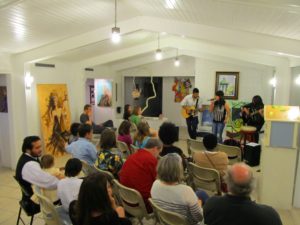
(“Nuestra Voz” open mic featuring Waco musicians Queen of Kings April 12, 2014 | photo: Jenuine Poetess)
Among the diverse offerings of the Art Forum is a monthly open mic, “Nuestra Voz”—Our Voice, co-hosted by Sanger Heights community leader Fernando Arroyo and your columnist truly, me! Every second Saturday evening around 6:45pm people gather–elders and youngers, poets and musicians, people across all cultures, genders, beliefs, abilities, practices, and experiences–to share poems, songs, stories, reflections—bits of ourselves, with each other. We build community together. We co-create art works and nourish inspiration.
When I asked, Why Waco? Why invest here? both gentlemen smiled wide, “Waco is a romantic city with its gorgeous river, its diversity, and beautiful artists,” Rivera said,
“Waco is in need of more spaces for artists, more public art, more beauty where people can pause and enjoy a moment of looking at something created for aesthetic pleasure. We have a saying, in Spanish, ‘la cultura empieza por la limpieza,’ ‘culture begins with cleanliness.’ Where there is public art, people respect it, they honor it. They will be motivated to keep the area clean, it cultivates a sense of pride in the neighborhood, in the city.”
Public art gives everyone a chance to be a part of something outside of ourselves and by taking part we cultivate agency and identity organically. We are creating the culture of Waco in each painting, story, song, dance, play, poem, and artistic expression we share.
To learn more about Saturday Art Classes, Nuestra Voz Open Mic, renting a studio space, attending an exhibit’s opening reception, please click here to visit The Art Forum of Waco’s Facebook page. To sign-up for Saturday Art Classes or find out more information, please call: (254) 652-5119 or email: [email protected].
The majority of Art Forum programming is free and open to all ages; donations are always welcome to support the efforts of Jesus Rivera and Arturo Huron and this rich centro of arts y cultura en Waco!
 Jenuine Poetess is an artist, visionary, and community organizer. In 2010, she founded In the Words of Womyn (ITWOW), an international, grass-roots, written and spoken-word arts project with chapters throughout Los Angeles; Waco, TX; and Lebanon. ITWOW empowers womyn of all ages to give sound to our story and volume to our voice. Jenuine also co-hosts Nuestra Voz & Word Gallery, monthly open mic venues for poetry, music, spoken-word, story-telling, and more! You can contact her at: [email protected].
Jenuine Poetess is an artist, visionary, and community organizer. In 2010, she founded In the Words of Womyn (ITWOW), an international, grass-roots, written and spoken-word arts project with chapters throughout Los Angeles; Waco, TX; and Lebanon. ITWOW empowers womyn of all ages to give sound to our story and volume to our voice. Jenuine also co-hosts Nuestra Voz & Word Gallery, monthly open mic venues for poetry, music, spoken-word, story-telling, and more! You can contact her at: [email protected].
by Ashley Bean Thornton
I love that Waco is small-big town or maybe a big-small city. We are small enough that rush hour is still more like “rush 15-minutes” and big enough to have a public radio station to listen to if you happen to get stuck at a light. (Thank you KWBU!) We are small enough that I run into people I know at the grocery store, and big enough that I meet new people with new ideas every day. We are a great size for a city…umm…town…umm…whatever…
Of course there are some challenges with being big-small. As sort of a “small town,” we might be tempted to believe that we all have the same ideas about what Waco should be, and how to go about getting there. In fact, we are big enough and diverse enough that there are many ideas about Waco. We need to make a point of listening to each other to pull those varied ideas together into one coherent vision. On the other hand, as sort of a “big city” we might be tempted to lapse into “big city apathy”– the unfortunate habit of letting “them” make all the decisions and then getting mad at “them” when “they” do something we don’t like. In fact, we are small enough that almost any of us could organize a group of like-minded residents and influence just about any decision being made in our city/town.
Because we are small-ish we all have the very real opportunity and responsibility to participate in the discussions and decisions that shape our community. Because we are big-ish, we need to take communication and participation seriously. It doesn’t just happen automatically. We have to be intentional about it. Our local government, school district and other institutions need to continue to provide opportunities for input, to make sure those opportunities are accessible to a wide range of people, and to publicize those opportunities far and wide in plenty of time for people to plan to participate. “We the people” need to take full advantage of the numerous opportunities available to us to join in the civic conversation. (The phrase “use it or lose it” comes to mind.) Here are a few ideas for doing that:
Participate in city planning with the new “Plan Greater Waco” on-line site at wacoplan.mindmixer.com. – The City of Waco and the Waco Metropolitan Planning Organization (MPO) are working right now on long-term plans that will shape and guide Waco for the next 10, 20, 30 years. The “Plan Greater Waco” site is open for everyone in the community to pitch ideas and give feedback on topics like “What are the three most important challenges facing Waco and McLennan County that we need to address between now and 2040?” and “What are our best resources that we should build on to strengthen our community?” On the site, you can give your own input, and see and comment on what your fellow residents are saying. It’s easy, and fun, and your feedback goes directly to the folks in the planning office.
Get involved with “Prosper Waco.” – Prosper Waco is our community-wide initiative to address challenges related to the high rate of poverty in Waco. Those guiding this initiative have wisely adopted a holistic approach of simultaneously working on health, education and financial stability. The initiative is designed based on the “Collective Impact” philosophy that calls for all of us to work together on a common agenda. Prosper Waco has been years in the making and has already benefitted from the input of many, many voices. If you would like to receive updates about the progress of Prosper Waco, send a note expressing your interest and requesting to be placed on the distribution list to [email protected].
Keep an eye out for town hall meetings and information sessions, and go! – Our various institutions – the city, the school district, the public health district, Waco Transit etc. – regularly hold town hall meetings and public information sessions for the express purpose of getting more community input into issues that affect our community. Even in this age of Facebook and Twitter, going to meeting is still a great way to get to know like-minded and different-minded neighbors, and to get to know the people who work for you in the various city, school-district, county and other public offices. Two great places to find out about meetings are the Waco Trib and Actlocallywaco.org. If you hear about a meeting that sounds important and interesting make it a habit to call a friend or neighbor and go!
Serve on a board, commission or committee – The civic work of our big-small community gets done to a large extent by boards, commissions and committees. There are over 30 boards and commissions listed on the City of Waco website and they welcome applications from every Waco resident. In addition to city boards and commissions, every non-profit in town has a board to help plan its work and committees to help carry out that work. Participation on one of these boards can give you a whole new appreciation for what is required to build a great community. Not sure you have the skills to serve on a board? Consider applying to participate in “Leadership Plenty,” a free 10-week leadership development program available to Wacoans who want to prepare themselves for effective civic participation. For more information, google “Leadership Plenty Institute Waco.”
Waco is a terrific place to live. We are big enough to dream audaciously, and small enough to know that we have to depend on each other and work together to make those dreams come true. A big “Thanks!” to all of you who are already working hard to make our community great. If you haven’t gotten involved yet, there’s no time like the present for joining in! Start with something small like leaving a comment on the wacoplan.mindmixer.com site or going to a meeting. Before you know it, you will be the one inviting others to the party!
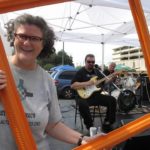 This Act Locally Waco blog post is by Ashley Bean Thornton, the Manager of the www.www.actlocallywaco.org website and the editor of the Friday Update newsletter. The Act Locally Waco blog publishes posts with a connection to these aspirations for Waco. If you are interested in writing for the Act Locally Waco Blog, please email [email protected] for more information.
This Act Locally Waco blog post is by Ashley Bean Thornton, the Manager of the www.www.actlocallywaco.org website and the editor of the Friday Update newsletter. The Act Locally Waco blog publishes posts with a connection to these aspirations for Waco. If you are interested in writing for the Act Locally Waco Blog, please email [email protected] for more information.



